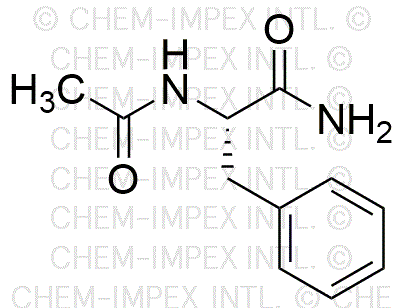Acetyl-L-phenylalanine amide is widely utilized in research focused on:
- Pharmaceutical Development: This compound serves as a building block in the synthesis of various pharmaceuticals, particularly in designing drugs that target neurological disorders.
- Peptide Synthesis: It is commonly used in the production of peptides, enhancing the stability and bioactivity of peptide-based therapeutics.
- Biochemical Research: Researchers employ it to study protein interactions and enzyme activities, providing insights into metabolic pathways.
- Cosmetic Formulations: The compound is included in skincare products for its potential to improve skin hydration and elasticity, appealing to the beauty industry.
- Food Industry: It can be utilized as a flavor enhancer or additive, contributing to the development of healthier food options without compromising taste.
Información general
Propiedades
Seguridad y normativas
Aplicaciones
Acetyl-L-phenylalanine amide is widely utilized in research focused on:
- Pharmaceutical Development: This compound serves as a building block in the synthesis of various pharmaceuticals, particularly in designing drugs that target neurological disorders.
- Peptide Synthesis: It is commonly used in the production of peptides, enhancing the stability and bioactivity of peptide-based therapeutics.
- Biochemical Research: Researchers employ it to study protein interactions and enzyme activities, providing insights into metabolic pathways.
- Cosmetic Formulations: The compound is included in skincare products for its potential to improve skin hydration and elasticity, appealing to the beauty industry.
- Food Industry: It can be utilized as a flavor enhancer or additive, contributing to the development of healthier food options without compromising taste.
Documentos
Hojas de datos de seguridad (HDS)
La SDS proporciona información de seguridad completa sobre la manipulación, el almacenamiento y la eliminación del producto.
Especificación del producto (PS)
La PS proporciona un desglose completo de las propiedades del producto, incluida la composición química, el estado físico, la pureza y los requisitos de almacenamiento. También detalla los rangos de calidad aceptables y las aplicaciones previstas del producto.
Certificados de análisis (COA)
Busque certificados de análisis (COA) ingresando el número de lote del producto. Los números de lote y de partida se pueden encontrar en la etiqueta de un producto después de las palabras "Lote" o "Lote".
Número de catálogo
Número de lote/lote
Certificados de origen (COO)
Este certificado de origen confirma el país en el que se fabricó el producto y también detalla los materiales y componentes utilizados en él y si se deriva de fuentes naturales, sintéticas u otras fuentes específicas. Este certificado puede ser necesario para cumplir con las normativas aduaneras, comerciales y regulatorias.
Número de catálogo
Número de lote/lote
Hojas de datos de seguridad (HDS)
La SDS proporciona información de seguridad completa sobre la manipulación, el almacenamiento y la eliminación del producto.
DownloadEspecificación del producto (PS)
La PS proporciona un desglose completo de las propiedades del producto, incluida la composición química, el estado físico, la pureza y los requisitos de almacenamiento. También detalla los rangos de calidad aceptables y las aplicaciones previstas del producto.
DownloadCertificados de análisis (COA)
Busque certificados de análisis (COA) ingresando el número de lote del producto. Los números de lote y de partida se pueden encontrar en la etiqueta de un producto después de las palabras "Lote" o "Lote".
Número de catálogo
Número de lote/lote
Certificados de origen (COO)
Este certificado de origen confirma el país en el que se fabricó el producto y también detalla los materiales y componentes utilizados en él y si se deriva de fuentes naturales, sintéticas u otras fuentes específicas. Este certificado puede ser necesario para cumplir con las normativas aduaneras, comerciales y regulatorias.


